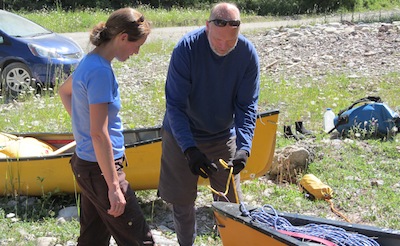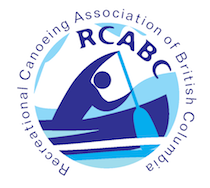
When canoeing anywhere in Canada, basic safety gear is required by Transport Canada but there's other gear that you should have along as well. It's all pretty useful stuff and makes sense, especially if you've ever had to use it! And yes, people have gotten tickets for not carrying the required TC gear.
SAFETY GEAR TOPICS:
- GEAR VARIES FOR DIFFERENT TYPES OF CANOEING
- TRANSPORT CANADA REQUIRED GEAR
- RCABC RECOMMENDED GEAR
- WEAR YOUR PFD!
- PFD'S AND LIFE JACKETS. THERE'S A DIFFERENCE
GEAR VARIES FOR DIFFERENT TYPES OF CANOEING
There are Transport Canada requirements and RCABC recommendations, but there are also different types of canoeing which can require different safety gear. These include:
- River canoeing
- Big canoes
- Standard lake canoeing
- C1 (closed canoe)
- Leading and instructing canoeing
Be sure you know the special requirements for what you are doing.
Back to Top...
TRANSPORT CANADA REQUIRED GEAR
Transport Canada requires all canoes to carry:
- Approved Personal Flotation Device or Life Jacket for each occupant. RCABC recommends you always WEAR your pfd when canoeing. Find more details about PFDs and Lifejackets below.
- A bailing device (for bailing rain water, excess water after a rescue, or water from waves)
- A sound making device (a whistle on your PFD is good for communicating)
- A minimum 15 metre buoyant heaving line (a throwbag with polypropylene rope for rescues)
- A light if going out at night
All of these items make sense to carry and have quickly available for emergencies.
Back to Top...
In addition to the TC requirements, RCABC recommends the following:
- A complete spare change of clothing along with other essentials in a waterproof container
- Floating polypropylene ropes (called painters) at each end of your canoe, roughly the length of your canoe (for rescues, securing your canoe, lining around rapids or hazards)
- A spare paddle (it's not uncommon to lose one)
- River gear if applicable (extra flotation, wetsuit/drysuit, helmet, river rescue gear, river pfd)
- Big Canoes and Closed Canoes (C-1s) have special requirements. Contact RCABC if you have any questions.
The vast majority of canoeing drowning could be prevented by wearing a PFD. Every year we here of new, tragic and yet preventable stories. Statistics consistently show British Columbia to have close to the highest rate of drowning in Canada and that canoeing has a very high rate of incidence.
Check out these reports from the Red Cross and Lifesaving BC
The highest risk factors for non-motorized, recreational boating drowning are:
- Not wearing a PFD
- Alcohol consumption
- Male (about 80%)
- Cold Water
- Canoeing
- Visitors to BC (BC waterways are unlike the rest of Canada and most places in the world)
PFD'S AND LIFE JACKETS. THERE'S A DIFFERENCE
You probably own a PFD, not a life jacket. A Life Jacket is what you'll find on a BC Ferry and is big and bulky in the front. They are designed to keep an exhausted, hypothermic or unconscious person floating face up so they can still breathe. A Personal Flotation Device does not try to keep you face up. But the vast majority of canoeists wear a PFD because they are designed for comfort and flotation, and this is important to us when canoeing. It is interesting to note that Paddle Canada refers to all of these devices as Life Jackers.
Choose one that is comfortable so that you'll wear it often. Do up all the buckles and zippers and make sure it fits snug. Choose a bright colour. Be a role model and wear it when around others, especially children. Make sure it is in good condition. PFDs and Life Jackets become less buoyant as they age and see heavy use. Replace them once they start aging. If you ended up in the water with waves washing over your head, ask yourself how important that may be.



















